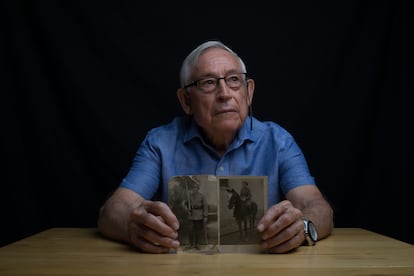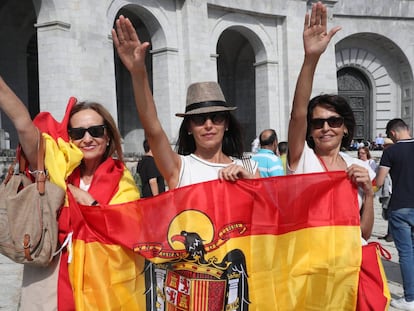Cuelgamuros: Four victims of Franco’s dictatorship finally identified
Fausto Canales was only 24 months old when the Falangists killed his father at the beginning of the Spanish Civil War. Now, at age 90, he can finally give him a dignified burial


Twenty years of struggle will be rewarded. A multidisciplinary team has been working in the crypts of Spain’s Valley of Cuelgamuros (formerly known as the Valley of the Fallen) since June 11, trying to return the remains of 133 people buried there without their families’ consent. Four victims – three men (Valerico Canales, Emilio Caro and Román González) and one woman (Flora Labajos) – have already been genetically identified, EL PAÍS has learned. They were in box 198, where the Franco regime had put the corpses of 12 victims of reprisals after removing them, in the middle of the dictatorship, from two mass graves in 1936 in Aldeaseca (Ávila) and Fuente el Saúz (Madrid). Fausto Canales had been asking for the return of his father’s remains since 2003.
“I’m thrilled, very happy,” explains Canales, 90. “I have been waiting for more than two decades for this moment. Since I retired in 1999 and started investigating my father’s whereabouts.” He was only 24 months old when a group of Falangists (Spanish fascists) took Valerico Canales, a 29-year-old day laborer and member of the UGT trade union, out of his house at dawn and killed him at the beginning of the Spanish Civil War. In 2003, after locating the mass grave where he had been buried with five other men and a woman, forensic anthropologists found that someone had removed the remains. Without informing their relatives, the Franco regime had moved the corpses to the Valley of the Fallen, now called Cuelgamuros, and in their haste, they had left behind a skull, finger bones, several vertebrae, dental remains, and Flora Labajos’ thimble in the ground. Upon learning of the transfer, Fausto began a battle to try to recover the remains. He took his case through all the courts, including the European Court of Human Rights in Strasbourg (France) and the Argentine justice system, which in 2010 opened a case against the crimes of Francoism.
At his home this Wednesday, surrounded by photographs of his parents, he summed up his satisfaction with the work that had been done: “I know that my father gave me hugs, but I can’t remember them because I was only two years old when he was killed. They didn’t allow me to meet him, but I know what he was like because my mother, who was in mourning for 30 years and never remarried, told me about him and throughout my life I have tried to imitate him, to follow his example. When the Minister [Félix Bolaños, head of the Ministry of the Presidency] called me this morning on behalf of the Prime Minister to tell me that he [his father] had been identified, I remembered her [his mother], who died in 2005, at the age of 99, and my brother, who died in 2021, on his 90th birthday. They were not able to see this, but they knew that I had devoted my life to recovering the remains and I know that today they would be very proud of me. That’s why I’m so thrilled.”
Fausto hopes that the rest of the victims from the same grave will also be identified, and he would like to bury them all together at the cenotaph that has been erected in their memory in his town. He believes that his uncle was also transferred to the Valley, but so far, he has not been identified.
In addition to Valerico Canales, the team of experts has also identified the remains of Emilio Caro, Flora Labajos and Román González, shot in 1936. The process is extremely complex because damp has affected the boxes where the victims were buried and the specialists have to proceed very carefully so that these receptacles do not fall apart. There is a photograph, which was key to the location of the remains, of the moment in which workers placed box 198 into the crypts of the Valley of Cuelgamuros at the end of the 1950s. Months of work remain to be done and whether it continues will depend on the results of Spain’s general election on July 23. The identified remains will not be delivered to the relatives until after the vote. Next Monday, the Secretary of State for Democratic Memory, Fernando Martínez, will meet at La Moncloa (the Spanish prime minister’s office and residence) with the 133 families who want to recover the remains of their loved ones to inform them of how the work is progressing.
A complete forensic laboratory has been set up inside the basilica of the Valley of Cuelgamuros, with X-ray equipment, microscopes, measuring tools, special tables, and lighting so that the multidisciplinary team of 15 experts can work. The operation, promoted by the center-left government to comply with the Law of Democratic Memory, involves, in addition to six forensic experts, a group of archaeologists, dentists, geneticists and four members of the forensic police, whose specific mission is to help identify the boxes in which the victims are buried if the inscription numbers are not clearly visible to the naked eye.
Sign up for our weekly newsletter to get more English-language news coverage from EL PAÍS USA Edition
Tu suscripción se está usando en otro dispositivo
¿Quieres añadir otro usuario a tu suscripción?
Si continúas leyendo en este dispositivo, no se podrá leer en el otro.
FlechaTu suscripción se está usando en otro dispositivo y solo puedes acceder a EL PAÍS desde un dispositivo a la vez.
Si quieres compartir tu cuenta, cambia tu suscripción a la modalidad Premium, así podrás añadir otro usuario. Cada uno accederá con su propia cuenta de email, lo que os permitirá personalizar vuestra experiencia en EL PAÍS.
¿Tienes una suscripción de empresa? Accede aquí para contratar más cuentas.
En el caso de no saber quién está usando tu cuenta, te recomendamos cambiar tu contraseña aquí.
Si decides continuar compartiendo tu cuenta, este mensaje se mostrará en tu dispositivo y en el de la otra persona que está usando tu cuenta de forma indefinida, afectando a tu experiencia de lectura. Puedes consultar aquí los términos y condiciones de la suscripción digital.
More information
Archived In
Últimas noticias
Most viewed
- Sinaloa Cartel war is taking its toll on Los Chapitos
- Reinhard Genzel, Nobel laureate in physics: ‘One-minute videos will never give you the truth’
- Oona Chaplin: ‘I told James Cameron that I was living in a treehouse and starting a permaculture project with a friend’
- Why the price of coffee has skyrocketed: from Brazilian plantations to specialty coffee houses
- David King, chemist: ‘There are scientists studying how to cool the planet; nobody should stop these experiments from happening’










































